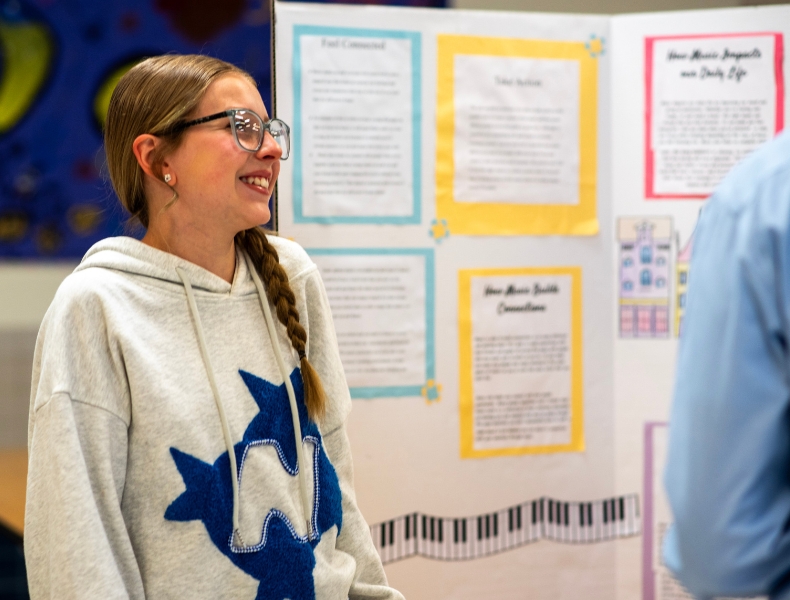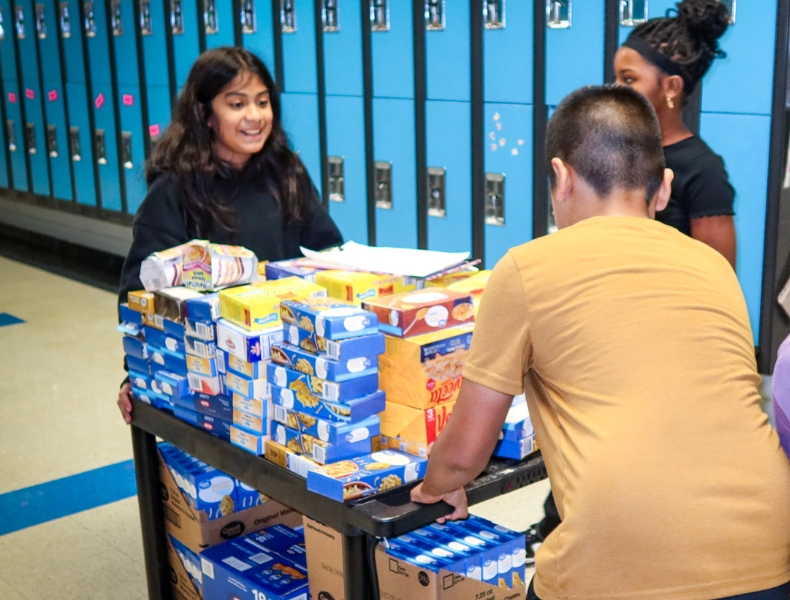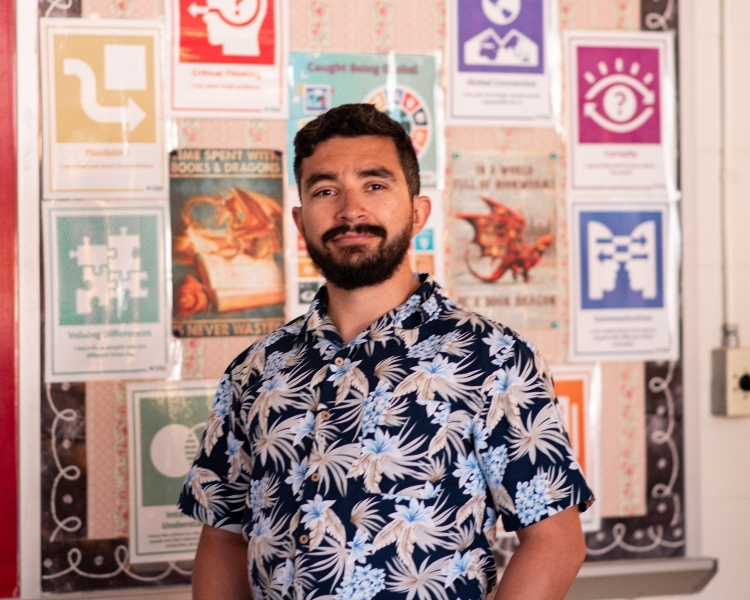Communication is at the heart of learning in every classroom. It shows up when students explain their thinking, listen during group work, ask for help, or present their ideas with confidence. And just like in school, strong communication is essential for success in every career.
In classrooms that intentionally build communication skills, students learn to adjust their messages for different audiences, express ideas clearly, and listen with empathy. These are the same skills professionals use when giving feedback, collaborating on teams, or presenting their work.

As one of ten core global competencies in Global Leaders, communication helps students grow academically while also preparing them for future careers. Becoming capable communicators means they can understand and express themselves with different kinds of people, an essential skill in any path they choose.
In this article, we’ll explore how communication skills develop in K–12, why they’re essential for students’ long-term success, and practical strategies to teach these skills across grade levels.
What Students Learn by Practicing Communication Skills in K–12
When students practice communication, they also build other career readiness skills, like critical thinking and curiosity, that work together to create effective leaders and collaborators. They learn how to engage with others in ways that are thoughtful, respectful, and effective. They consider their audience, organize their thinking, and respond with clarity and empathy.
These habits support success in every subject area and carry over into future careers. In classrooms that prioritize communication, students learn to:
- Explain their thinking and support it with evidence
- Adjust their tone and message based on their audience
- Listen actively to understand, not just to reply
- Use body language and visuals to strengthen their message
- Ask meaningful questions and respond with purpose
As students build these skills, they’re also preparing for the realities of work and life beyond school. Communicating across differences, giving and receiving feedback, and presenting ideas with confidence are all essential parts of modern careers, from healthcare and education to business, science, and public service.
When students have opportunities to practice real-world communication in the classroom, they grow into collaborators, leaders, and problem-solvers ready to thrive in a connected world.

Classroom Strategies to Teach Communication Skills in K–12
Communication can take many forms, including verbal, nonverbal, written, and visual. To strengthen their communication skills, students need consistent, low-stakes opportunities to practice all of these different modes. Here are four high-impact strategies to help students build this competency across communication types:
1. Use Turn-and-Talks to Build Confidence and Clarity
Before whole-class discussions, have students practice their ideas with a partner. Prompt them with questions like:
- “What’s one thing you noticed?”
- “How would you explain this in your own words?”
- “What questions do you still have?”
This simple structure helps students clarify their thinking and prepare to share with the group, especially for students who need extra processing time.
Career connection: Practicing how to express ideas clearly and listen actively builds core communication skills used in interviews, meetings, and collaborative projects across every profession.
2. Add Purpose and Audience to Writing Tasks
Even in early grades, students can begin tailoring their writing for different audiences. Switch up the audience and have students write letters to school leaders, thank-you notes to community helpers, or posters that explain a local challenge to younger students.
Career connection: Adjusting tone, structure, and message based on audience mirrors the writing demands of real-world careers, in everything from public relations to journalism to STEM fields.
3. Teach Active Listening Through Observation and Practice
Active listening means focusing fully on the speaker, interpreting both verbal and nonverbal cues, and responding in a way that shows understanding. Help students explore what this looks like by watching a short video together and asking:
- How did the listener show they were listening?
- What helped the listener stay focused?
- What made communication easier or harder?
Then, practice active listening in pairs or small groups with sentence stems like:
- “What I hear you saying is…”
- “I’d like to build on that idea…”
- “I agree with [name] because…”
- “I have a different perspective…”
Career connection: Active listening is essential in fields like health care, education, law enforcement, and leadership, where understanding others is key to solving problems and building trust.

4. Encourage Visual Communication with Creative Formats
Give students opportunities to express their ideas beyond just writing or speaking. They might design a poster for a community or school event, draw a comic strip to explain a concept, or record a short video reflection.
Career connection: The ability to communicate ideas in different formats is vital in today’s workforce, from social media and marketing to design, tech, and the arts.
Want to help your students build communication skills that matter? Download our free Global Competency Chart and start building future-ready classrooms today.
Real-World Example: Teaching Communication Through Student TED Talks
At Melaleuca Elementary in West Palm Beach, Florida, fourth- and fifth-grade students took on a challenge that pushed their communication skills to new levels: giving their own TED-style talks.
Each student selected a global issue that mattered to them—from clean water access to environmental sustainability—and researched its causes and impact. With support from their teachers, they crafted messages designed to inform, persuade, and inspire. Students practiced speaking clearly, organizing their ideas, and adjusting their tone and pacing for their audience.
They presented to their classmates and school community, sharing their ideas with families, peers, and staff.
This project gave students the chance to practice real-world communication: public speaking, visual communication, and message design. It also gave them confidence. They walked away with a deeper belief in their ability to express themselves and influence others.
By combining research, storytelling, and presentation, students experienced firsthand how communication connects learning to purpose and how their voices can make an impact far beyond the classroom.
Want to strengthen communication in your classroom or school? Download our free Global Competency Chart and explore more ways to build future-ready skills through Global Leaders.
Frequently Asked Questions About Teaching Communication Skills in K–12
How do I assess communication skills effectively?
Use communication rubrics that focus on specific, observable behaviors like eye contact, voice clarity, and active listening. Combine teacher observations with peer assessment and student self-reflection to create a comprehensive picture of growth over time.
What strategies work best for shy or reluctant speakers?
Start with low-stakes opportunities like turn-and-talks or small group discussions before moving to whole-class sharing. Provide sentence stems and allow students to prepare their thoughts in advance. Celebrate small steps and consistently invite students to contribute without forcing participation.
How do communication strategies differ across grade levels?
Elementary students benefit from concrete sentence stems and visual cues, while middle and high schoolers can handle more complex discussion structures, peer feedback, and larger communication-focused projects.
What technology tools support communication skill development?
Digital storytelling platforms, video reflection tools, and collaborative discussion boards can enhance communication practice. However, face-to-face interaction remains essential. Use technology to supplement, not replace, in-person communication opportunities.
How can I integrate communication skills across different subjects?
Every subject offers communication opportunities, like science discussions about observations, math explanations of problem-solving strategies, and social studies debates about topics in history, government, and economics. Look for natural integration points rather than treating communication as a separate skill.
What’s the best way to handle disagreements during discussions?
The best way to handle conflict is to address it before it arises. Model how to focus on ideas rather than personalities, and establish clear norms about respectful dialogue. Teach students to disagree respectfully using phrases like “I see it differently because…” and consider incorporating activities that strengthen the global competency of valuing differences.
How do I know if my communication instruction is working?
Look for increased student participation, more thoughtful responses, and students naturally using communication strategies you’ve taught. Regular check-ins and student reflections can help you adjust your approach based on their needs and growth.
Why Communication Skills Matter for Career-Ready Students
When students build strong communication skills, they become good speakers and writers, effective teammates, thoughtful leaders, and confident problem-solvers. They learn to listen deeply, express ideas clearly, and adapt their message to make an impact.
These are the same skills they’ll need in the workforce: Whether they’re collaborating across teams, presenting new ideas, or working with people from different backgrounds, communication will be at the core.
At Participate Learning, we’re proud to partner with schools that are helping students grow into globally aware, career-ready communicators, starting with meaningful practice in the classroom.
Looking for support in developing career readiness skills like communication in your students? Learn more about how Global Leaders equips students to excel as leaders in a world that demands innovation, collaboration, and a global perspective.




